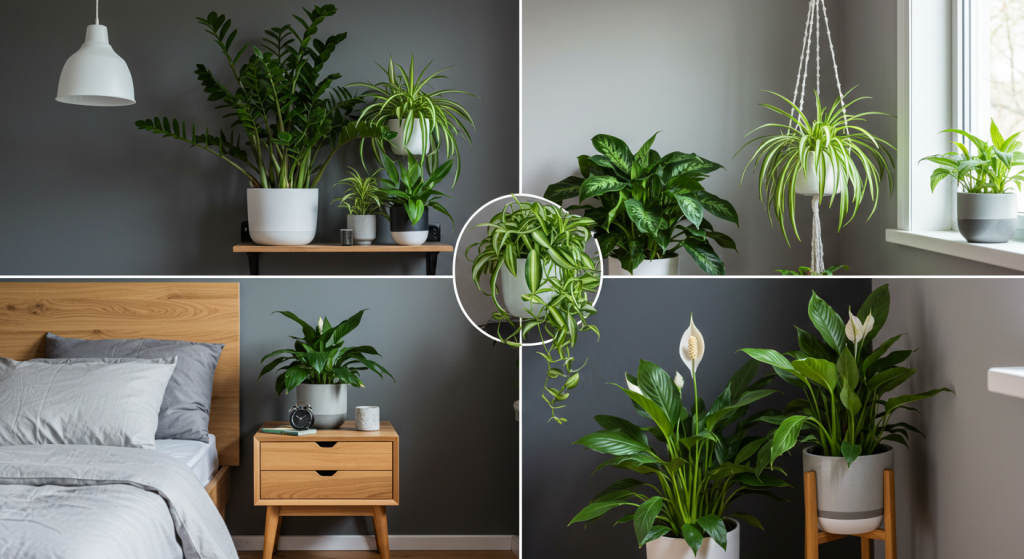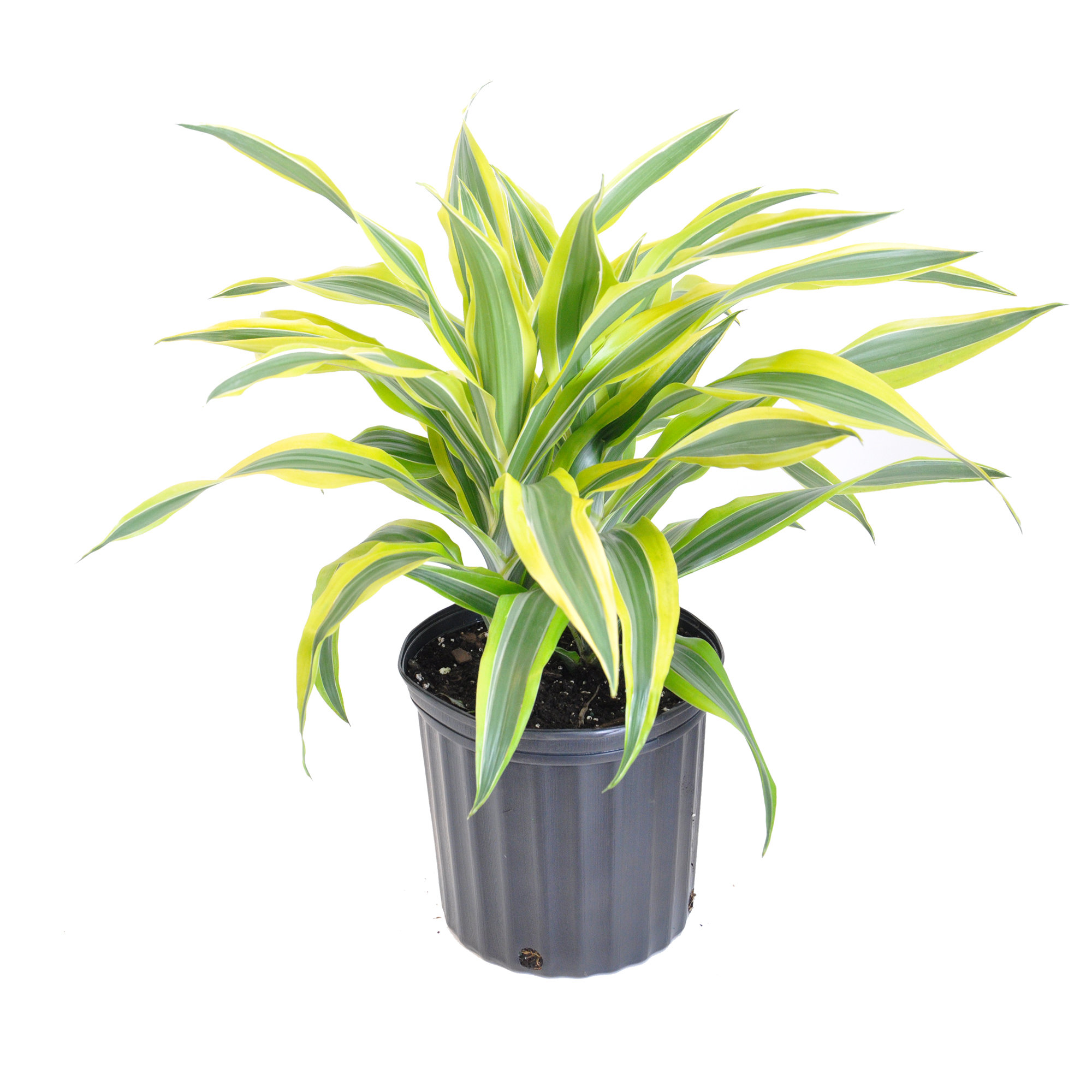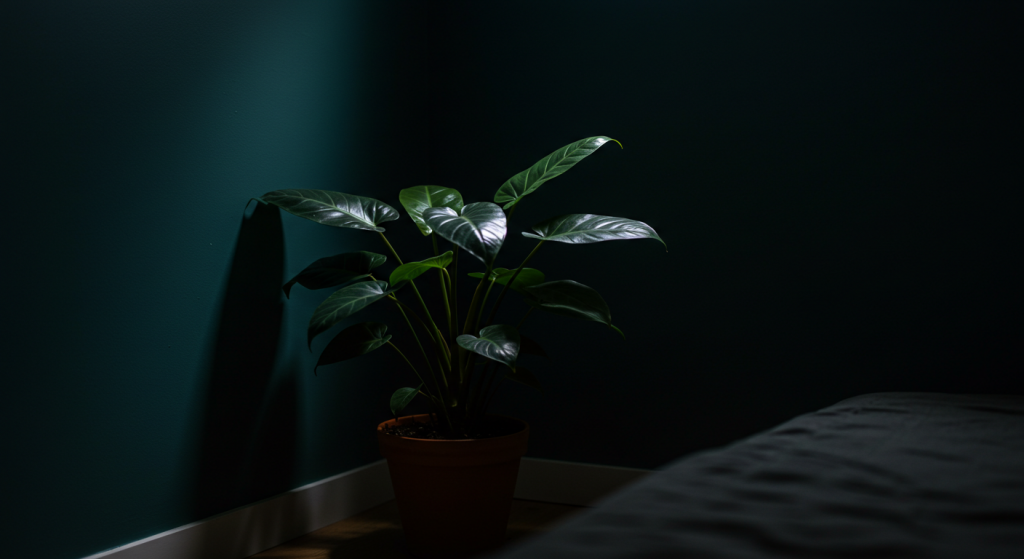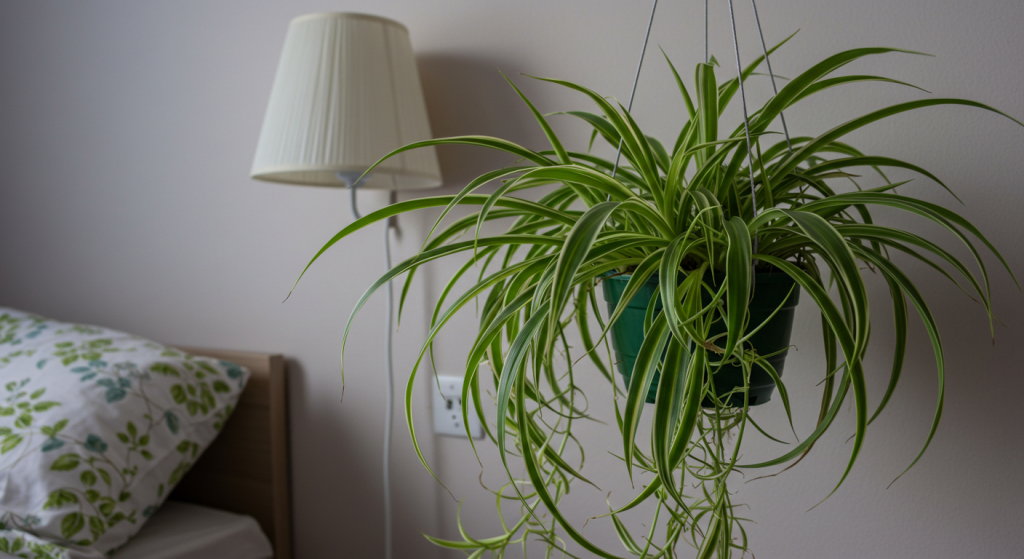If your bedroom feels dull and lifeless, you’re not alone. Many people want to enjoy the benefits of houseplants but worry that dim conditions will make them difficult to maintain. The truth is that several varieties thrive in low-light environments, especially in bedrooms. In this article, you’ll discover the best plants for low-light bedrooms and learn how to keep them healthy—even if you don’t have a sunny windowsill. You’ll also see which ones help purify air, improve humidity, and create a soothing ambiance for better sleep. Let’s dive in!
Table of content
- Why Choose Low-Light Plants for the Bedroom?
- Top 9 Best Plants for Low-Light Bedrooms
- 1. Snake Plant (Sansevieria trifasciata)
- 2. ZZ Plant (Zamioculcas zamiifolia)
- 3. Pothos (Epipremnum aureum)
- 4. Peace Lily (Spathiphyllum)
- 5. Parlor Palm (Chamaedorea elegans)
- 6. English Ivy (Hedera helix)
- 7. Dracaena (Dracaena spp.)
- 8. Chinese Evergreen (Aglaonema)
- 9. Spider Plant (Chlorophytum comosum)
- Comparison Table of Care Requirements
- FAQs
- “Do Low-Light Plants Actually Purify the Air?”
- “Is It Safe to Keep Plants in the Bedroom?”
- “How Do I Keep Plants Alive in Low Light?”
- “What if My Bedroom Has No Windows?”
- Extra Tips for a Thriving Indoor Garden
- Conclusion: Create a Peaceful Oasis with Low-Light Plants
Why Choose Low-Light Plants for the Bedroom?

Bedrooms often have smaller windows or face away from direct sunlight. Some homeowners also keep curtains drawn for privacy or to block out early morning light. This scenario means finding plants that can survive—and even thrive—with limited light exposure.
Low-light plants offer multiple benefits:
- Better Air Quality: According to a NASA Clean Air Study (source: NASA.gov), certain indoor plants can remove toxins like benzene and formaldehyde from the air.
- Improved Ambiance: Greenery can soften a room’s appearance and create a calming environment, helpful for promoting rest.
- Low Maintenance: Low-light plants typically require less frequent watering and less direct sun, making them ideal for busy individuals or plant beginners.
If you’ve ever wondered how to spruce up a bedroom without daily fuss, low-light houseplants are an excellent solution.
Top 9 Best Plants for Low-Light Bedrooms
Below are nine tried-and-tested options that are commonly featured in lists of the best plants for low-light bedrooms. Each one has its own unique traits, so choose the one that best suits your style and needs.
1. Snake Plant (Sansevieria trifasciata)

REAL PLANTS: Each order includes a real snake plant (Sansevieria Laurentii) in a 1-gallon plant pot. Known for their variegated foliage, snake plants are lovely house plants or office plants. Enjoy...
- Why It’s Great: Known as the “Mother-in-Law’s Tongue,” this plant releases oxygen at night, making it perfect for bedrooms.
- Light & Care: Tolerates almost any light level, from low to bright. Water once every 2–3 weeks. Overwatering can lead to root rot.
- Fun Fact: Snake plants are among the top plants recommended in NASA’s Clean Air Study for filtering toxins.
2. ZZ Plant (Zamioculcas zamiifolia)

ZZ Plant (Zamioculcas Zamiifolia)
Glossy, dark green leaves
Indirect sunlight
Allow top inch of soil to dry
Tolerates various temperatures and low humidity
- Why It’s Great: ZZ plants have glossy, thick leaves that store water. They thrive in low-light conditions and require minimal care.
- Light & Care: Place it in indirect light; direct sunlight can scorch its leaves. Water only when the top inch of soil is dry.
- Fun Fact: They are extremely forgiving—if you forget to water for a month, they’ll probably still look great.
3. Pothos (Epipremnum aureum)

The golden pothos is a popular houseplant that grows vines that can train or climb. The foliage is green with vibrant, yellow variegation. Pothos are extremely adaptable, low-maintenance and forgiv...
- Why It’s Great: Pothos, also known as “Devil’s Ivy,” is famously hardy. It can handle low light and is known for its trailing vines.
- Light & Care: Adaptable to various light conditions but prefers bright, indirect light. Water when the soil feels dry to the touch.
- Fun Fact: Pothos is a superb choice if you love hanging plants or want to drape vines across furniture.
4. Peace Lily (Spathiphyllum)

𝐋𝐈𝐕𝐄 𝐈𝐍𝐃𝐎𝐎𝐑 𝐏𝐋𝐀𝐍𝐓 This plant has lush leaves, pearly white blooms, and is known to filter toxins from the air. It droops when it is thirsty, so it's a good fit for beginners. It's also known to bri...
- Why It’s Great: Peace lilies have elegant white blooms and lush green leaves. They can tolerate dim spaces and have air-purifying qualities.
- Light & Care: Thrives in low to medium light. Water weekly or when the plant starts to droop.
- Fun Fact: It’s among the few indoor plants that can bloom in low light.
5. Parlor Palm (Chamaedorea elegans)

𝐋𝐈𝐕𝐄 𝐈𝐍𝐃𝐎𝐎𝐑 𝐏𝐋𝐀𝐍𝐓 The Parlor Palm, also known as the Neanthe Bella Palm is a plant perfect for beginners. Naturally, it's a slow grower (takes several years to reach 3-4ft tall), is adaptable to mo...
- Why It’s Great: With its feathery fronds, the parlor palm adds a tropical feel to your bedroom.
- Light & Care: Prefers low to medium light. Keep soil slightly moist, but avoid overwatering.
- Fun Fact: It was a Victorian-era favorite due to its ability to grow in dim parlors.
6. English Ivy (Hedera helix)

LIVE HOUSEPLANT: Ivy Plant, or as it is also known Hedera Helix, is a vigorous evergreen vine, widely used for the decoration of houses. Its dense dark to light green foliage on the thin stem can e...
- Why It’s Great: English ivy has trailing vines that can climb or hang, making it versatile for bedrooms.
- Light & Care: Prefers bright, indirect light but tolerates lower light levels. Water once the topsoil is slightly dry.
- Fun Fact: According to certain studies, English ivy may help reduce mold spores in the air, though more research is needed (source: NCBI).
7. Dracaena (Dracaena spp.)

- Why It’s Great: Dracaena plants come in various colors and leaf patterns, from striped to multihued.
- Light & Care: Prefers low to moderate light; direct sunlight can scorch the leaves. Water every 1–2 weeks, depending on soil dryness.
- Fun Fact: The name “Dracaena” is derived from the Greek word for “female dragon,” referencing its sap’s reddish color in some species.
8. Chinese Evergreen (Aglaonema)

- Why It’s Great: Known for its patterned leaves, Chinese evergreen is incredibly easy to care for, even in poor light.
- Light & Care: Does well in low light but can benefit from occasional indirect light. Water when the top inch of soil is dry.
- Fun Fact: It’s one of the oldest houseplants in Asian culture, valued for its hardiness and ornamental leaves.
9. Spider Plant (Chlorophytum comosum)

Variegated Spider Plant Chlorophytum Comosum Live potted Houseplant in 4" Pot
Very easy care and tolerates a variety of conditions.
Need to brighten up your home or office, this is the perfect hous...
- Why It’s Great: The spider plant is famous for its spiderettes—baby offshoots that hang from the main plant.
- Light & Care: Adapts to low light but prefers bright, indirect sun. Water moderately, keeping soil slightly moist.
- Fun Fact: Spider plants are pet-friendly and often used in homes with curious cats or dogs.
Comparison Table of Care Requirements
To help you decide which is right for you, here’s a quick-reference table:
| Plant | Light Level | Watering Frequency | Special Care |
|---|---|---|---|
| Snake Plant | Low to Bright | Every 2–3 weeks | Avoid overwatering |
| ZZ Plant | Low to Moderate | Every 2–3 weeks | Let soil dry between waterings |
| Pothos | Low to Bright Indirect | When soil is dry to the touch | Prune trailing vines to maintain shape |
| Peace Lily | Low to Moderate | Weekly or when leaves droop | Mist leaves for extra humidity |
| Parlor Palm | Low to Moderate | Weekly, slightly moist soil | Keep away from direct sunlight |
| English Ivy | Low to Bright Indirect | Once topsoil is dry (about weekly) | Trim regularly to control growth |
| Dracaena | Low to Moderate | Every 1–2 weeks | Avoid direct sunlight |
| Chinese Evergreen | Low to Moderate | Every 1–2 weeks | Wipe leaves to remove dust |
| Spider Plant | Low to Bright Indirect | Weekly, slightly moist soil | Remove spiderettes to propagate |
Use this table to quickly calculate watering schedules. For instance, if your home’s humidity level is lower, you might water more often. A rough formula for frequency could be:
FAQs

“Do Low-Light Plants Actually Purify the Air?”
Yes. Several plants in this list—such as the Snake Plant and Peace Lily—have been studied for their air-purifying capabilities. Though you’ll need multiple plants to have a noticeable effect, every little bit helps (source: NASA.gov).
“Is It Safe to Keep Plants in the Bedroom?”
Absolutely. Many people worry about plants releasing carbon dioxide at night, but the amount is minuscule compared to the oxygen released during the day. Moreover, some plants (like Snake Plant) release oxygen at night, making them ideal bedroom companions.
“How Do I Keep Plants Alive in Low Light?”
Choose the right species (like those mentioned above), maintain a consistent watering schedule, and occasionally rotate the plant to help even out light exposure. If possible, open curtains for a few hours of indirect light each day or use a gentle grow light.
“What if My Bedroom Has No Windows?”
You can still grow low-light plants using artificial lights. Look for full-spectrum LED grow lights. These lights mimic natural sunlight and can be kept on for 12–14 hours a day. Ensure good air circulation to prevent mold or mildew.
Extra Tips for a Thriving Indoor Garden

- Dust the Leaves: Accumulated dust can block sunlight, so gently wipe leaves with a damp cloth every few weeks.
- Use the Right Soil: Fast-draining potting mixes work best. Consider adding perlite or sand to improve aeration.
- Fertilize Sparingly: Most low-light plants need minimal fertilization—once every 1–2 months with a balanced, water-soluble fertilizer is often sufficient.
- Group Plants for Humidity: Clustering plants together can increase the moisture in the air, creating a mini “green zone.”
Conclusion: Create a Peaceful Oasis with Low-Light Plants
Adding low-light houseplants to your bedroom can transform it into a calming, refreshing space. Whether you prefer the elegant Peace Lily, the hardy ZZ Plant, or the timeless Snake Plant, there’s a perfect match for every style. Each of these best plants for low-light bedrooms can help improve air quality, elevate decor, and promote better rest—all with minimal effort.
Ready to get started? Pick one or two favorites from the list, gather the necessary potting supplies, and spend an afternoon greening up your bedroom. With just a little care, you’ll soon enjoy a more tranquil and rejuvenating place to sleep.
The responses below are not provided, commissioned, reviewed, approved, or otherwise endorsed by any financial entity or advertiser. It is not the advertiser’s responsibility to ensure all posts and/or questions are answered.

